Towards Figurative Expression Enhancement: Effects of the SVVR-Supported Worked Example Approach on the Descriptive Writing of Highly Engaged Students
Abstract
:1. Introduction
- Does the SVVR-supported worked example approach significantly affect descriptive writing performance?
- Does engagement level significantly influence descriptive writing performance?
- Is there any interaction effect between learning approach and engagement level on descriptive writing performance?
2. Theoretical Background
3. The SVVR-Supported Worked Example Approach for Descriptive Article Writing
4. Experiment Design
4.1. Participants
4.2. Measurement Instruments
4.2.1. Rubric of Descriptive Writing Performance
4.2.2. Questionnaire of Engagement
4.3. Experimental Procedure
4.4. Statistical Analysis
5. Results
5.1. Analysis of Organization
5.2. Analysis of Sensory Details
5.3. Analysis of Figurative Expression
5.4. Analysis of Creativity
5.5. Comparison of Two Samples from Two Different Groups
6. Discussion
6.1. Effects of the SVVR-Supported Worked Example Approach
6.2. Effects of Engagement Level
6.3. Interaction Effects between the Learning Approach and Engagement Level
7. Conclusions
Author Contributions
Funding
Institutional Review Board Statement
Informed Consent Statement
Data Availability Statement
Acknowledgments
Conflicts of Interest
References
- Ter Horst, E.E.; Pearce, J.M. Foreign languages and sustainability: Addressing the connections, communities, and comparisons standards in higher education. Foreign Lang. Ann. 2010, 43, 365–383. [Google Scholar] [CrossRef]
- Cai, J.-Y.; Wang, R.-F.; Wang, C.-Y.; Ye, X.-D.; Li, X.-Z. The influence of learners’ cognitive style and testing environment supported by virtual reality on English-speaking learning achievement. Sustainability 2021, 13, 11751. [Google Scholar] [CrossRef]
- Wang, Y.-H. Exploring the effectiveness of integrating augmented reality-based materials to support writing activities. Comput. Educ. 2017, 113, 162–176. [Google Scholar] [CrossRef]
- Tse, S.-K.; Hui, S.-Y. Chinese writing curriculum reforms in Hong Kong in recent years and their impact on teaching and learning. Read. Writ. 2016, 29, 1013–1037. [Google Scholar] [CrossRef]
- Beam, S.; Williams, C. Technology-mediated writing instruction in the early literacy program: Perils, procedures, and possibilities. Comput. Sch. 2015, 32, 260–277. [Google Scholar] [CrossRef]
- Hussin, S.; Abdullah, M.Y.; Ismail, N.; Yoke, S.K. The effects of CMC applications on ESL writing anxiety among postgraduate students. Engl. Lang. Teach. 2015, 8, 167–172. [Google Scholar] [CrossRef]
- Huang, H.-L.; Hwang, G.-J.; Chang, C.-Y. Learning to be a writer: A spherical video-based virtual reality approach to supporting descriptive article writing in high school Chinese courses. Br. J. Educ. Technol. 2020, 51, 1386–1405. [Google Scholar] [CrossRef]
- Li, X.; Chu, S.K.W. Using design-based research methodology to develop a pedagogy for teaching and learning of Chinese writing with wiki among Chinese upper primary school students. Comput. Educ. 2018, 126, 359–375. [Google Scholar] [CrossRef]
- Vyotsky, L. Mind in Society: The Development of Higher Psychological Processes; Harvard University Press: Cambridge, MA, USA, 1978. [Google Scholar]
- Mortazavi, M.; Jafarigohar, M.; Roohi, A. Can scaffolding mechanisms of structuring and problematizing facilitate the transfer of genre-based knowledge to another discourse mode? J. Teach. Lang. Skills 2017, 35, 133–156. [Google Scholar]
- Rittle-Johnson, B. Promoting transfer: Effects of self-explanation and direct instruction. Child Dev. 2006, 77, 1–15. [Google Scholar] [CrossRef] [PubMed]
- Renkl, A.; Atkinson, R.K.; Große, C.S. How fading worked solution steps works—A cognitive load perspective. Instr. Sci. 2004, 32, 59–82. [Google Scholar] [CrossRef] [Green Version]
- Atkinson, R.K.; Renkl, A.; Merrill, M.M. Transitioning from studying examples to solving problems: Effects of self-explanation prompts and fading worked-out steps. J. Educ. Psychol. 2003, 95, 774–783. [Google Scholar] [CrossRef] [Green Version]
- Lewis, L.H.; Williams, C.J. Experiential learning: Past and present. In New Directions for Adult and Continuing Education; Jackson, L., Caffarella, R.S., Eds.; Jossey-Bass: San Francisco, CA, USA, 1994; pp. 5–16. [Google Scholar]
- Gibbs, R. Embodiment and Cognitive Science; Cambridge University Press: New York, NY, USA, 2005. [Google Scholar]
- Antle, A.N.; Corness, G.; Droumeva, M. What the body knows: Exploring the benefits of embodied metaphors in hybrid physical digital environments. Interact. Comput. 2009, 21, 66–75. [Google Scholar] [CrossRef]
- Fischer, U.; Moeller, K.; Bientzle, M.; Cress, U.; Nuerk, H.C. Sensori-motor spatial training of number magnitude representation. Psychon. Bull. Rev. 2011, 18, 177–183. [Google Scholar] [CrossRef]
- Zhou, J. The effects of reciprocal imitation on teacher-student relationships and student learning outcomes. Mind Brain Educ. 2012, 6, 66–73. [Google Scholar] [CrossRef]
- Prensky, M. Digital natives, digital immigrants part 1. On Horizon 2001, 9, 1–6. [Google Scholar] [CrossRef] [Green Version]
- Cheng, S.-C.; Hwang, G.-J.; Chen, C.-H. From reflective observation to active learning: A mobile experiential learning approach for environmental science education. Br. J. Educ. Technol. 2019, 50, 2251–2270. [Google Scholar] [CrossRef]
- Huang, X.; Zou, D.; Cheng, G.; Xie, H. A systematic review of AR and VR enhanced language learning. Sustainability 2021, 13, 4639. [Google Scholar] [CrossRef]
- Aiello, P.; D’Elia, F.; Di Tore, S.; Sibilio, M. A constructivist approach to virtual reality for experiential learning. E-Learn. Digit. Media 2012, 9, 317–324. [Google Scholar] [CrossRef]
- Jarmon, L.; Traphagan, T.; Mayrath, M.; Trivedi, A. Virtual world teaching, experiential learning, and assessment: An inter-disciplinary communication course in Second Life. Comput. Educ. 2009, 53, 169–182. [Google Scholar] [CrossRef]
- Kwon, C. Verification of the possibility and effectiveness of experiential learning using HMD-based immersive VR technologies. Virtual Real. 2019, 23, 101–118. [Google Scholar] [CrossRef] [Green Version]
- Su, C.-H.; Cheng, T.-W. A sustainability innovation experiential learning model for virtual reality chemistry laboratory: An empirical study with PLS-SEM and IPMA. Sustainability 2019, 11, 1027. [Google Scholar] [CrossRef] [Green Version]
- Merchant, Z.; Goetz, E.T.; Cifuentes, L.; Keeney-Kennicutt, W.; Davis, T.J. Effectiveness of virtual reality-based instruction on students’ learning outcomes in K-12 and higher education: A meta-analysis. Comput. Educ. 2014, 70, 29–40. [Google Scholar] [CrossRef]
- Lloyd, A.; Rogerson, S.; Stead, G. Imagining the potential for using virtual reality technologies in language learning. In Digital Language Learning and Teaching: Research, Theory, and Practice; Carrier, M., Damerow, R.M., Bailey, K.M., Eds.; Routledge: New York, NY, USA, 2017; pp. 222–234. [Google Scholar]
- Patera, M.; Draper, S.; Naef, M. Exploring magic cottage: A virtual reality environment for stimulating children’s imaginative writing. Interact. Learn. Environ. 2008, 16, 245–263. [Google Scholar] [CrossRef] [Green Version]
- Shadiev, R.; Yang, M. Review of studies on technology-enhanced language learning and teaching. Sustainability 2020, 12, 524. [Google Scholar] [CrossRef] [Green Version]
- Yang, J.C.; Chen, C.H.; Jeng, M.C. Integrating video-capture virtual reality technology into a physically interactive learning environment for English learning. Comput. Educ. 2010, 55, 1346–1356. [Google Scholar] [CrossRef]
- Allcoat, D.; von Mühlenen, A. Learning in virtual reality: Effects on performance, emotion and engagement. Res. Learn. Technol. 2018, 26, 1–13. [Google Scholar] [CrossRef] [Green Version]
- Yang, G.; Chen, Y.-T.; Zheng, X.-L.; Hwang, G.-J. From experiencing to expressing: A virtual reality approach to facilitating pupils’ descriptive paper writing performance and learning behavior engagement. Br. J. Educ. Technol. 2021, 52, 807–823. [Google Scholar] [CrossRef]
- Fredricks, J.A.; Blumenfeld, P.C.; Paris, A.H. School engagement: Potential of the concept, state of the evidence. Rev. Educ. Res. 2004, 74, 59–109. [Google Scholar] [CrossRef] [Green Version]
- Furrer, C.; Skinner, E. Sense of relatedness as a factor in children’s academic engagement and performance. J. Educ. Psychol. 2003, 95, 148–162. [Google Scholar] [CrossRef]
- Grljević, O.; Bošnjak, Z.; Kovačević, A. Opinion mining in higher education: A corpus-based approach. Enterp. Inf. Syst. 2020, 1–26. [Google Scholar] [CrossRef]
- Liu, C.K. A holistic approach to flipped classroom: A conceptual framework using e-platform. Int. J. Eng. Bus. Manag. 2019, 11, 1–9. [Google Scholar] [CrossRef]
- Challob, A.I. The effect of flipped learning on EFL students’ writing performance, autonomy, and motivation. Educ. Inf. Technol. 2021, 26, 3743–3769. [Google Scholar] [CrossRef]
- Kolb, D.A. Experiential Learning: Experience as the Source of Learning and Development; Prentice-Hall: Englewood Cliffs, NJ, USA, 1984. [Google Scholar]
- Lee, E.A.-L.; Wong, K.W. Learning with desktop virtual reality: Low spatial ability learners are more positively affected. Comput. Educ. 2014, 79, 49–58. [Google Scholar] [CrossRef] [Green Version]
- Lorenzo, G.; Lledó, A.; Pomares, J.; Roig, R. Design and application of an immersive virtual reality system to enhance emotional skills for children with autism spectrum disorders. Comput. Educ. 2016, 98, 192–205. [Google Scholar] [CrossRef] [Green Version]
- Martirosov, S.; Bureš, M.; Zítka, T. Cyber sickness in low-immersive, semi-immersive, and fully immersive virtual reality. Virtual Real. 2021, 1–18. [Google Scholar] [CrossRef]
- Cheung, K.L.; Tunik, E.; Adamovich, S.V.; Boyd, L.A. Neuroplasticity and virtual reality. In Virtual Reality for Physical and Motor Rehabilitation; Weiss, P., Keshner, E., Levin, M., Eds.; Springer: New York, NY, USA, 2014; pp. 5–24. [Google Scholar]
- Coco-Martin, M.B.; Piñero, D.P.; Leal-Vega, L.; Hernández-Rodríguez, C.J.; Adiego, J.; Molina-Martín, A.; de Fez, D.; Arenillas, J.F. The potential of virtual reality for inducing neuroplasticity in children with amblyopia. J. Ophthalmol. 2020, 2020, 1–9. [Google Scholar] [CrossRef]
- Calvert, J.; Abadia, R. Impact of immersing university and high school students in educational linear narratives using virtual reality technology. Comput. Educ. 2020, 159, 104005. [Google Scholar] [CrossRef]
- Ye, X.; Liu, P.-F.; Lee, X.-Z.; Zhang, Y.-Q.; Chiu, C.-K. Classroom misbehaviour management: An SVVR-based training system for preservice teachers. Interact. Learn. Environ. 2021, 29, 112–129. [Google Scholar] [CrossRef]
- Sun, F.-R.; Pan, L.-F.; Wan, R.-G.; Li, H.; Wu, S.-J. Detecting the effect of student engagement in an SVVR school-based course on higher level competence development in elementary schools by SEM. Interact. Learn. Environ. 2021, 29, 3–16. [Google Scholar] [CrossRef]
- Lee, S.H.; Sergueeva, K.; Catangui, M.; Kandaurova, M. Assessing Google Cardboard virtual reality as a content delivery system in business classrooms. J. Educ. Bus. 2017, 92, 153–160. [Google Scholar] [CrossRef]
- Chang, S.-C.; Hsu, T.-C.; Chen, Y.-N.; Jong, M.S.-Y. The effects of spherical video-based virtual reality implementation on students’ natural science learning effectiveness. Interact. Learn. Environ. 2020, 28, 915–929. [Google Scholar] [CrossRef]
- Wu, J.; Guo, R.; Wang, Z.; Zeng, R. Integrating spherical video-based virtual reality into elementary school students’ scientific inquiry instruction: Effects on their problem-solving performance. Interact. Learn. Environ. 2021, 29, 496–509. [Google Scholar] [CrossRef]
- Jong, M.S.-Y.; Tsai, C.-C.; Xie, H.; Wong, F.K.-K. Integrating interactive learner-immersed video-based virtual reality into learning and teaching of physical geography. Br. J. Educ. Technol. 2020, 51, 2064–2079. [Google Scholar] [CrossRef]
- Ulrich, F.; Helms, N.H.; Frandsen, U.P.; Rafn, A.V. Learning effectiveness of 360° video: Experiences from a controlled experiment in healthcare education. Interact. Learn. Environ. 2021, 29, 98–111. [Google Scholar] [CrossRef]
- Kittel, A.; Larkin, P.; Elsworthy, N.; Spittle, M. Using 360 degrees virtual reality as a decision-making assessment tool in sport. J. Sci. Med. Sport 2019, 22, 1049–1053. [Google Scholar] [CrossRef]
- Alpala, D.P.O.; Peña, N.M. A virtual room to enhance writing skills in the EFL class. HOW 2014, 21, 62–81. [Google Scholar] [CrossRef] [Green Version]
- Xu, Y.; Park, H.; Baek, Y. A new approach toward digital storytelling: An activity focused on writing self-efficacy in a virtual learning environment. J. Educ. Techno. Soc. 2011, 14, 181–191. [Google Scholar]
- Chen, M.-R.A.; Hwang, G.-J. Effects of experiencing authentic contexts on English speaking performances, anxiety and motivation of EFL students with different cognitive styles. Interact. Learn. Environ. 2020, 1–21. [Google Scholar] [CrossRef]
- Chien, S.-Y.; Hwang, G.-J.; Jong, M.S.-Y. Effects of peer assessment within the context of spherical video-based virtual reality on EFL students’ English-speaking performance and learning perceptions. Comput. Educ. 2020, 146, 103751. [Google Scholar] [CrossRef]
- Dolgunsöz, E.; Yildirim, G.; Yildirim, S. The effect of virtual reality on EFL writing performance. J. Lang. Linguist. Stud. 2018, 14, 278–292. [Google Scholar]
- Walshe, N.; Driver, P. Developing reflective trainee teacher practice with 360-degree video. Teach. Teach. Educ. 2019, 78, 97–105. [Google Scholar] [CrossRef]
- Di Serio, Á.; Ibáñez, M.B.; Kloos, C.D. Impact of an augmented reality system on students’ motivation for a visual art course. Comput. Educ. 2013, 68, 586–596. [Google Scholar] [CrossRef] [Green Version]
- Dunn, T.J.; Kennedy, M. Technology enhanced learning in higher education; motivations, engagement and academic achievement. Comput. Educ. 2019, 137, 104–113. [Google Scholar] [CrossRef]
- Cheung, W.M.; Tse, S.K.; Tsang, W.H.H. Development and validation of the Chinese creative writing scale for primary school students in Hong Kong. J. Creat. Behav. 2001, 35, 249–260. [Google Scholar] [CrossRef]
- Yeung, P.-S.; Ho, C.S.-H.; Chan, D.W.-O.; Chung, K.K.-H. Writing motivation and performance in Chinese children. Read. Writ. 2020, 33, 427–449. [Google Scholar] [CrossRef]
- Suriyanti, S.; Yaacob, A. Exploring teacher strategies in teaching descriptive writing in Indonesia. Malays. J. Learn. Instr. 2016, 13, 71–95. [Google Scholar] [CrossRef]
- Skinner, E.; Furrer, C.; Marchand, G.; Kindermann, T. Engagement and disaffection in the classroom: Part of a larger motivational dynamic? J. Educ. Psychol. 2008, 100, 765–781. [Google Scholar] [CrossRef] [Green Version]
- Cohen, J. Statistical Power Analysis for the Behavioral Sciences, 2nd ed.; Routledge Academic: New York, NY, USA, 1988. [Google Scholar]
- Styati, E.W. Effect of YouTube videos and pictures on EFL students’ writing performance. Din. Ilmu 2016, 16, 307–317. [Google Scholar] [CrossRef]
- Paas, F.; Renkl, A.; Sweller, J. Cognitive load theory and instructional design: Recent developments. Educ. Psychol. 2003, 38, 1–4. [Google Scholar] [CrossRef]
- Gibbs, R.W.; Leggitt, J.S.; Turner, E.A. What’s special about figurative language in emotional communication? In The Verbal Communication of Emotions: Interdisciplinary Perspectives; Fussell, S.R., Ed.; Lawrence Erlbaum: Mahwah, NJ, USA, 2002; pp. 125–149. [Google Scholar]
- Newmann, F.M.; Wehlage, G.G.; Lamborn, S.D. The significance and sources of student engagement. In Student Engagement and Achievement in American Secondary Schools; Newmann, F.M., Ed.; Teachers College Press: New York, NY, USA, 1992; pp. 11–39. [Google Scholar]
- Appleton, J.J.; Christenson, S.L.; Furlong, M.J. Student engagement with school: Critical conceptual and methodological issues of the construct. Psychol. Sch. 2008, 45, 369–386. [Google Scholar] [CrossRef]
- Baron, P.; Corbin, L. Student engagement: Rhetoric and reality. High. Educ. Res. Dev. 2012, 31, 759–772. [Google Scholar] [CrossRef]
- Finn, J.D. School Engagement and Students at Risk; National Center for Education Statistics: Washington, DC, USA, 1993. [Google Scholar]
- Marks, H.M. Student engagement in instructional activity: Patterns in the elementary, middle, and high school years. Am. Educ. Res. J. 2000, 37, 153–184. [Google Scholar] [CrossRef]
- Van Waes, L.; van Weijen, D.; Leijten, M. Learning to write in an online writing center: The effect of learning styles on the writing process. Comput. Educ. 2014, 73, 60–71. [Google Scholar] [CrossRef]
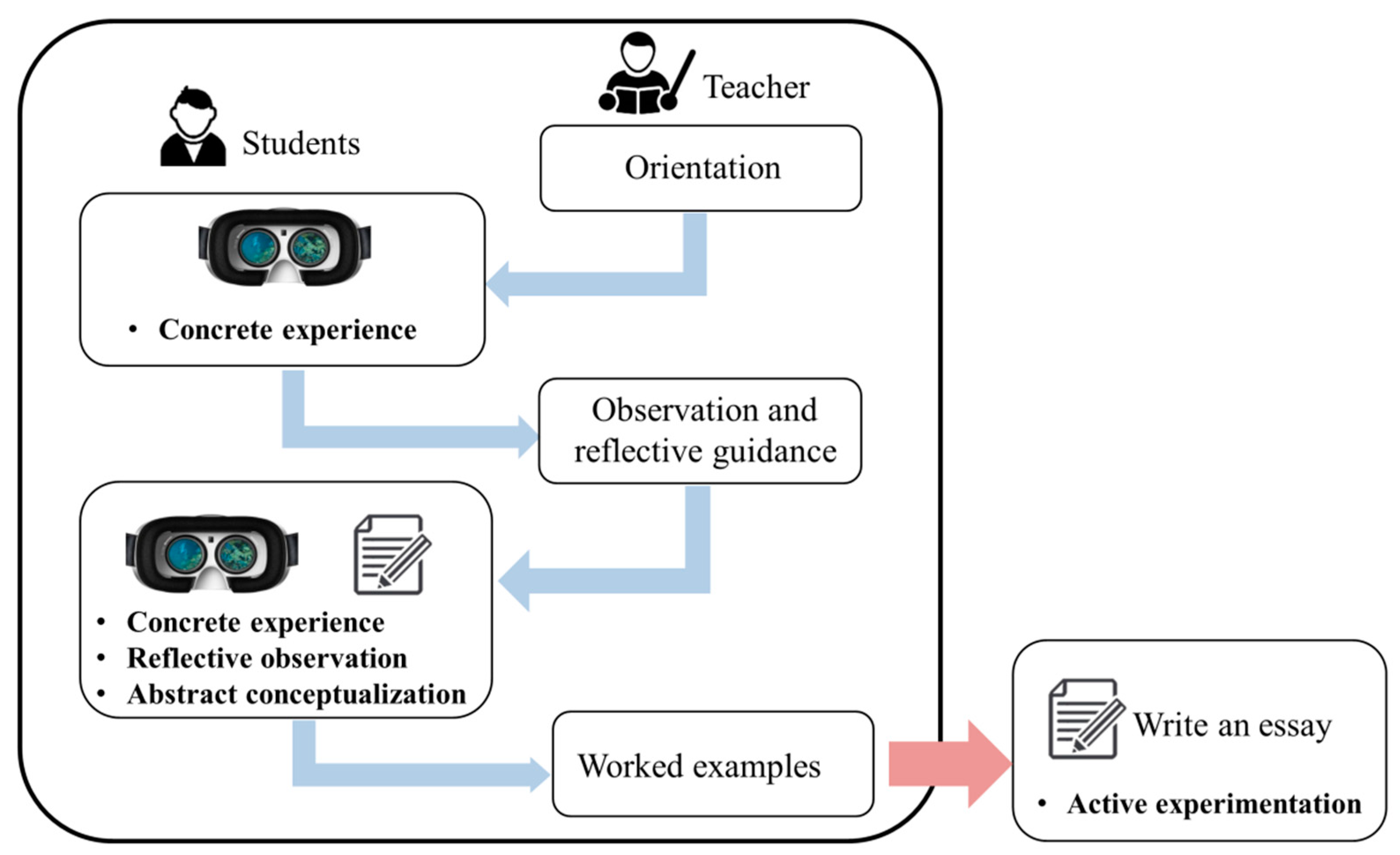
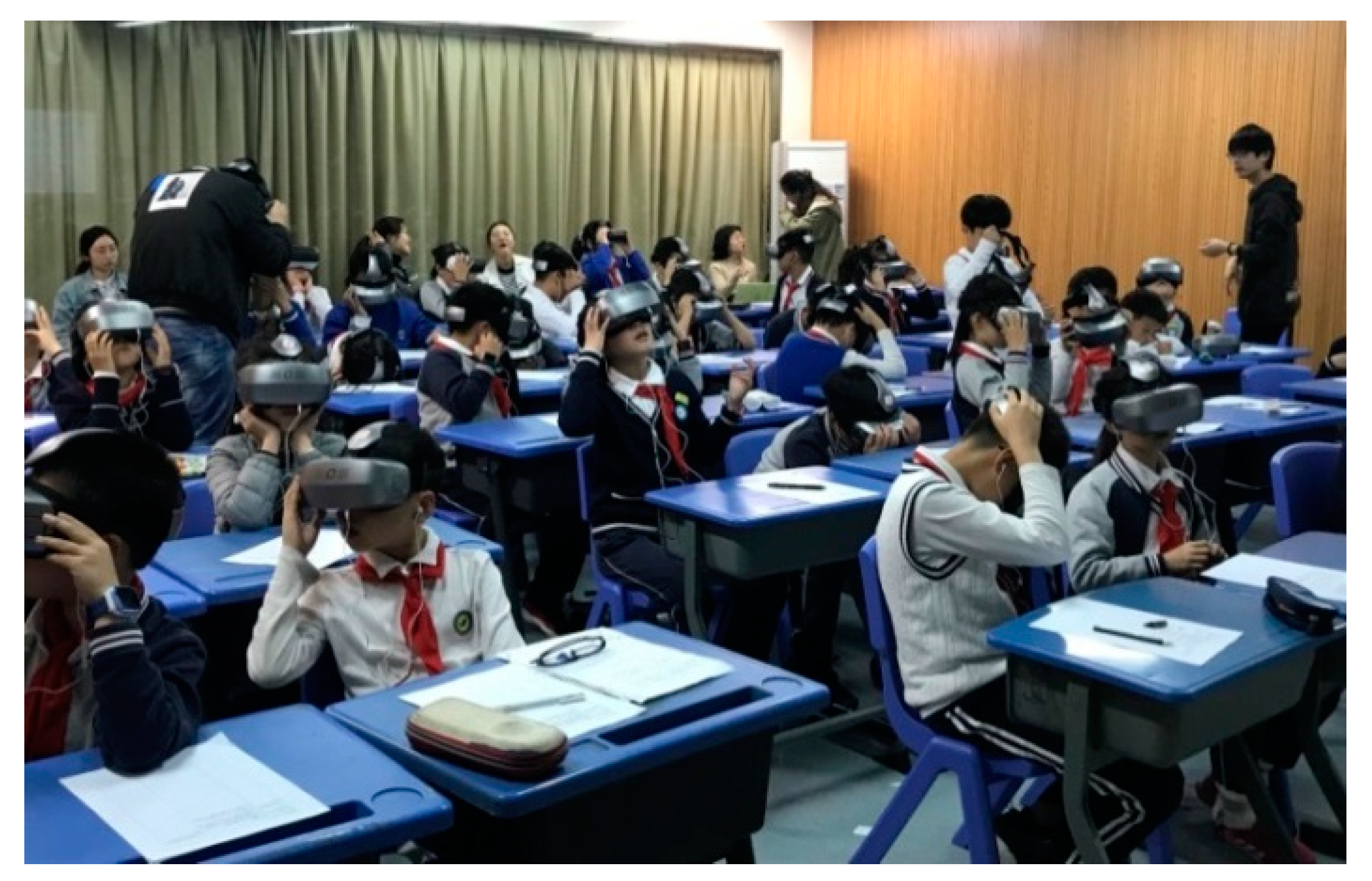
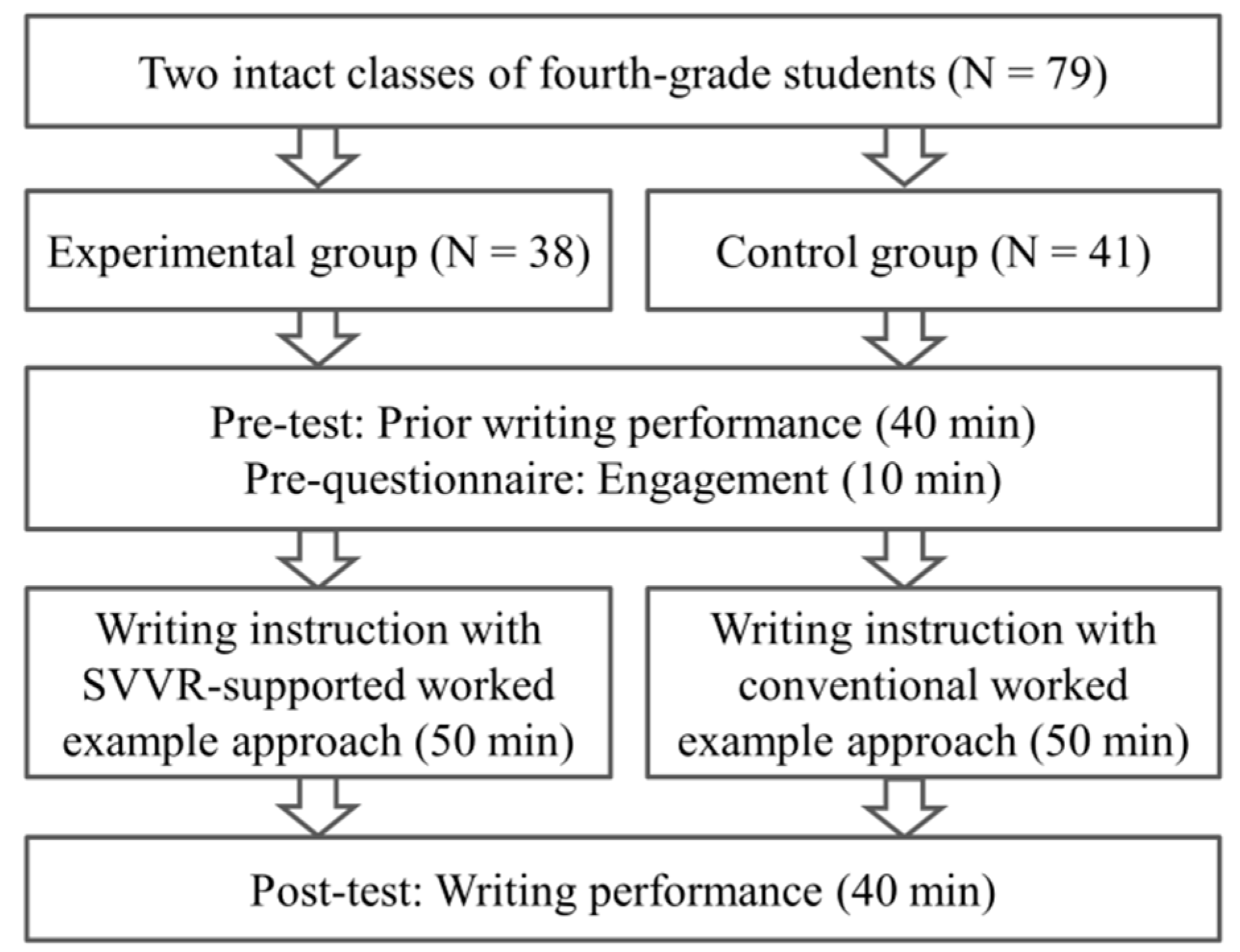
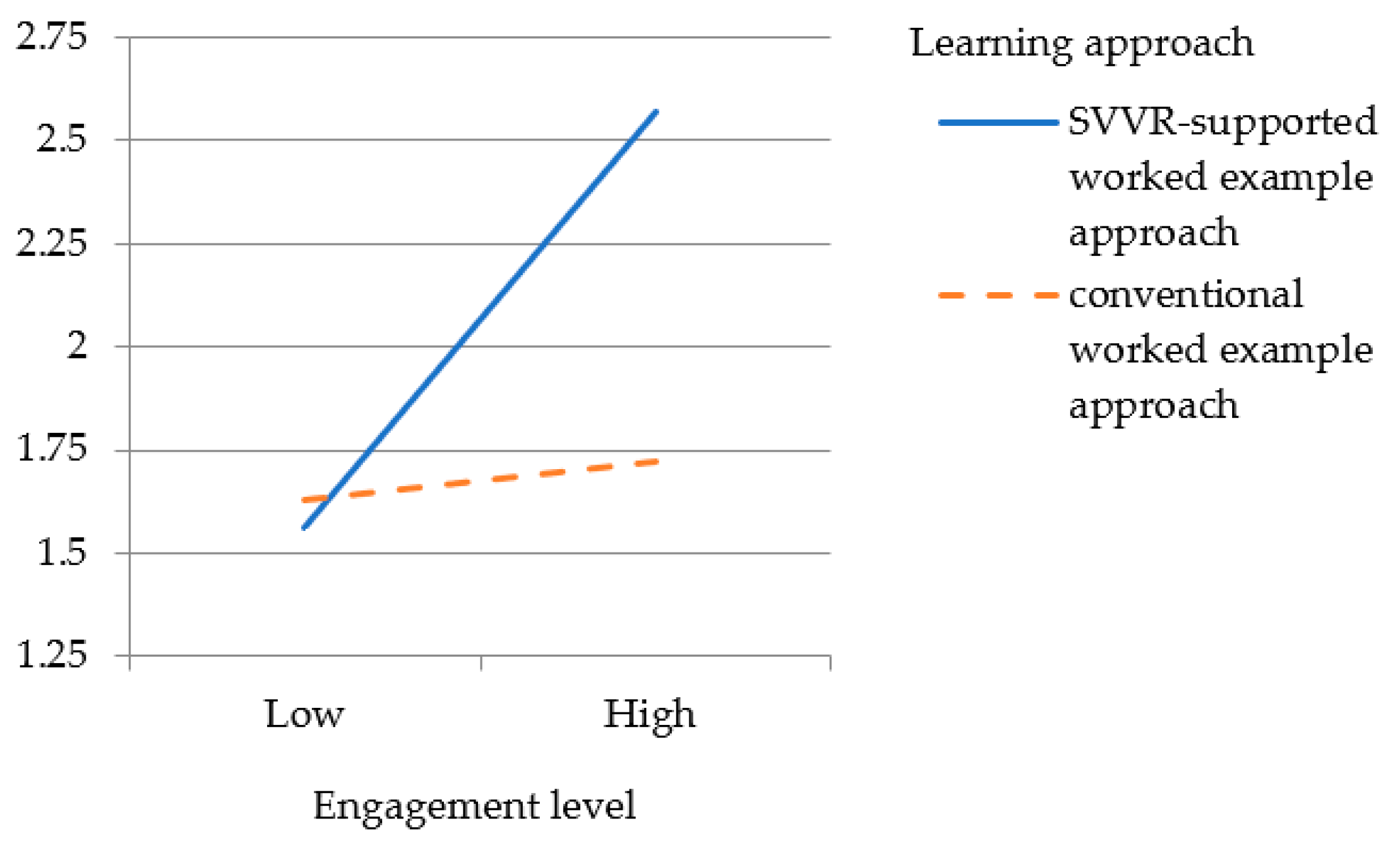
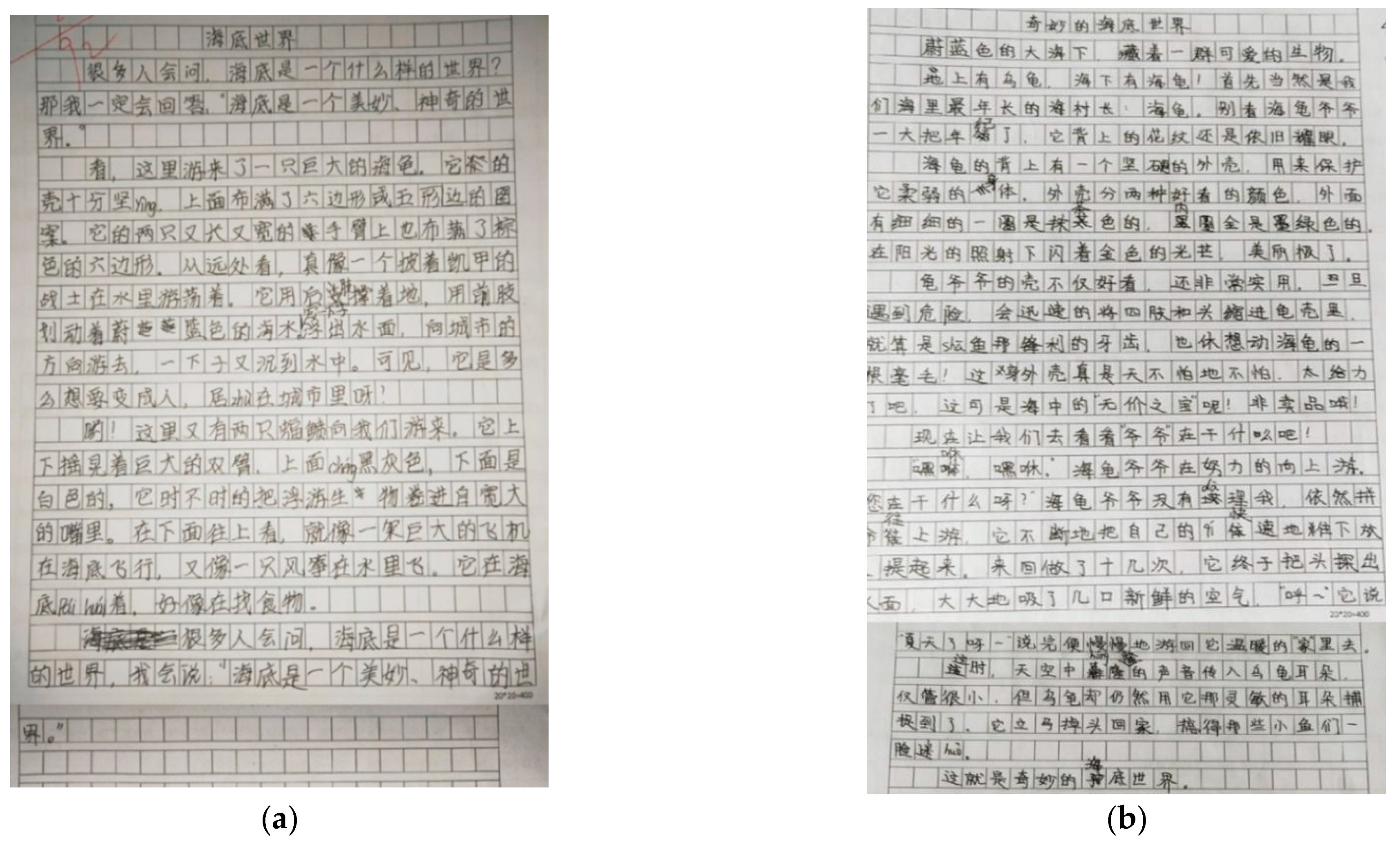
| Components | 4—Expert | 3—Practitioner | 2—Apprentice | 1—Novice |
|---|---|---|---|---|
| Organization | The structure of the written composition is well organized, coherent, and thoughtful with a logical and analytical progression of ideas. | The structure of the written composition is slightly loose. There is some inconsistency but the overall organization is coherent. | The structure of the written composition is simple. The organization is somewhat loose and not coherent. | The structure of the written composition is not clear with incorrect paragraphing. |
| Sensory details | Accurately writes multiple sensory details such as sight, sound, touch, smell, and taste. | Appropriately writes sensory details such as sight, sound, touch, smell, and taste. | Attempts to write sensory details such as sight, sound, touch, smell, and taste. | Fails to write sensory details such as sight, sound, touch, smell, and taste. |
| Figurative expression | Accurately uses various analogies, similes, or metaphors to describe the features of the subject. | Appropriately uses several analogies, similes, or metaphors to describe the features of the subject. | Attempts to use several analogies, similes, or metaphors to describe the features of the subject. | Fails to use or incorrectly uses analogies, similes, or metaphors to describe the features of the subject. |
| Creativity | Writes creative and original ideas. | Writes somewhat creative and original ideas. | Attempts to write creative and original ideas. | Not able to write creative and original ideas. |
| Source of Variation | SS | df | MS | F | p | η² |
|---|---|---|---|---|---|---|
| learning approach | 1.48 | 1 | 1.48 | 3.30 | 0.073 | 0.04 |
| engagement | 3.07 | 1 | 3.07 | 6.84 * | 0.011 | 0.09 |
| learning approach × engagement | 1.29 | 1 | 1.29 | 2.87 | 0.094 | 0.04 |
| error | 33.21 | 74 | 0.45 | |||
| total | 945.00 | 79 |
| Condition | Engagement Level (n) | Pre-Test | Post-Test | |
|---|---|---|---|---|
| M (SD) | M (SD) | Adjusted Mean (SE) | ||
| Video + worked example | low (n = 23) | 3.04 (0.56) | 3.09 (0.79) | 3.16 (0.15) |
| high (n = 18) | 3.67 (0.49) | 3.39 (0.70) | 3.33 (0.16) | |
| total (n = 41) | 3.32 (0.61) | 3.22 (0.76) | 3.24 (0.11) | |
| SVVR + worked example | low (n = 18) | 3.33 (0.59) | 3.17 (0.79) | 3.18 (0.16) |
| high (n = 20) | 3.55 (0.60) | 3.90 (0.31) | 3.86 (0.15) | |
| total (n = 38) | 3.45 (0.60) | 3.55 (0.69) | 3.52 (0.11) | |
| total | low (n = 41) | 3.17 (0.59) | 3.12 (0.78) | 3.17 (0.11) |
| high (n = 38) | 3.61 (0.55) | 3.66 (0.58) | 3.59 (0.11) | |
| total (n = 79) | 3.38 (0.61) | 3.38 (0.74) | ||
| Source of Variation | SS | df | MS | F | p | η² |
|---|---|---|---|---|---|---|
| learning approach | 1.81 | 1 | 1.81 | 3.32 | 0.072 | 0.04 |
| engagement | 2.59 | 1 | 2.59 | 4.76 * | 0.032 | 0.06 |
| learning approach × engagement | 2.13 | 1 | 2.13 | 3.91 | 0.052 | 0.05 |
| error | 40.27 | 74 | 0.54 | |||
| total | 452.00 | 79 |
| Condition | Engagement level (n) | Pre-Test | Post-Test | |
|---|---|---|---|---|
| M (SD) | M (SD) | Adjusted Mean (SE) | ||
| Video + worked example | low (n = 23) | 1.96 (0.82) | 2.04 (0.88) | 2.08 (0.15) |
| high (n = 18) | 2.44 (0.86) | 2.22 (0.65) | 2.12 (0.18) | |
| total (n = 41) | 2.17 (0.86) | 2.12 (0.78) | 2.10 (0.12) | |
| SVVR + worked example | low (n = 18) | 1.89 (0.68) | 2.00 (0.84) | 2.05 (0.18) |
| high (n = 20) | 2.05 (0.69) | 2.75 (0.64) | 2.76 (0.17) | |
| total (n = 38) | 1.97 (0.68) | 2.40 (0.82) | 2.41 (0.12) | |
| total | low (n = 41) | 1.93 (0.75) | 2.02 (0.85) | 2.07 (0.12) |
| high (n = 38) | 2.24 (0.79) | 2.50 (0.69) | 2.44 (0.12) | |
| total (n = 79) | 2.08 (0.78) | 2.25 (0.81) | ||
| Source of Variation | SS | df | MS | F | p | η² |
|---|---|---|---|---|---|---|
| learning approach | 2.88 | 1 | 2.88 | 4.86 * | 0.031 | 0.06 |
| engagement | 5.16 | 1 | 5.16 | 8.71 ** | 0.004 | 0.11 |
| learning approach × engagement | 4.18 | 1 | 4.18 | 7.07 * | 0.010 | 0.09 |
| error | 43.81 | 74 | 0.59 | |||
| total | 340.00 | 79 |
| Condition | Engagement Level (n) | Pre-Test | Post-Test | |
|---|---|---|---|---|
| M (SD) | M (SD) | Adjusted Mean (SE) | ||
| video + worked example | low (n = 23) | 1.61 (0.78) | 1.61 (0.58) | 1.63 (0.16) |
| high (n = 18) | 2.11 (0.76) | 1.83 (0.86) | 1.72 (0.19) | |
| total (n = 41) | 1.83 (0.80) | 1.71 (0.72) | 1.67 (0.12) | |
| SVVR + worked example | low (n = 18) | 1.28 (0.46) | 1.44 (0.51) | 1.56 (0.19) |
| high (n = 20) | 1.80 (0.89) | 2.60 (1.10) | 2.57 (0.17) | |
| total (n = 38) | 1.55 (0.76) | 2.05 (1.04) | 2.07 (0.13) | |
| total | low (n = 41) | 1.46 (0.67) | 1.54 (0.55) | 1.60 (0.13) |
| high (n = 38) | 1.95 (0.84) | 2.24 (1.05) | 2.14 (0.13) | |
| total (n = 79) | 1.70 (0.79) | 1.87 (0.90) | ||
| Source of Variation | SS | df | MS | F | p |
|---|---|---|---|---|---|
| learning approach | |||||
| learning approach @ low engagement | 0.06 | 1 | 0.06 | 0.22 | 0.640 |
| learning approach @ high engagement | 6.81 | 1 | 6.81 | 7.24 * | 0.011 |
| engagement | |||||
| engagement @ video + worked example | 0.001 | 1 | 0.00 | 0.00 | 0.953 |
| engagement @ SVVR + worked example | 9.99 | 1 | 9.99 | 12.95 ** | 0.001 |
| Source of Variation | SS | df | MS | F | p | η² |
|---|---|---|---|---|---|---|
| learning approach | 0.07 | 1 | 0.07 | 0.13 | 0.725 | 0.00 |
| engagement | 5.43 | 1 | 5.43 | 9.91 ** | 0.002 | 0.12 |
| learning approach × engagement | 0.74 | 1 | 0.74 | 1.35 | 0.250 | 0.02 |
| error | 40.59 | 74 | 0.55 | |||
| total | 375.00 | 79 |
| Condition | Engagement Level (n) | Pre-Test | Post-Test | |
|---|---|---|---|---|
| M (SD) | M (SD) | Adjusted Mean (SE) | ||
| video + worked example | low (n = 23) | 1.70 (0.82) | 1.74 (0.75) | 1.81 (0.16) |
| high (n = 18) | 2.33 (0.91) | 2.28 (0.89) | 2.16 (0.18) | |
| total (n = 41) | 1.98 (0.91) | 1.98 (0.85) | 1.99 (0.12) | |
| SVVR + worked example | low (n = 18) | 1.72 (0.83) | 1.61 (0.50) | 1.67 (0.18) |
| high (n = 20) | 2.05 (0.89) | 2.45 (0.89) | 2.42 (0.17) | |
| total (n = 38) | 1.90 (0.86) | 2.05 (0.84) | 2.05 (0.12) | |
| total | low (n = 41) | 1.71 (0.81) | 1.68 (0.65) | 1.74 (0.12) |
| high (n = 38) | 2.18 (0.90) | 2.37 (0.88) | 2.29 (0.12) | |
| total (n = 79) | 1.94 (0.88) | 2.01 (0.84) | ||
Publisher’s Note: MDPI stays neutral with regard to jurisdictional claims in published maps and institutional affiliations. |
© 2021 by the authors. Licensee MDPI, Basel, Switzerland. This article is an open access article distributed under the terms and conditions of the Creative Commons Attribution (CC BY) license (https://creativecommons.org/licenses/by/4.0/).
Share and Cite
Huang, Y.-P.; Zheng, X.-L.; Chiu, C.-K.; Lei, J.; Yang, G.; Kim, H.; Wang, F. Towards Figurative Expression Enhancement: Effects of the SVVR-Supported Worked Example Approach on the Descriptive Writing of Highly Engaged Students. Sustainability 2021, 13, 12260. https://doi.org/10.3390/su132112260
Huang Y-P, Zheng X-L, Chiu C-K, Lei J, Yang G, Kim H, Wang F. Towards Figurative Expression Enhancement: Effects of the SVVR-Supported Worked Example Approach on the Descriptive Writing of Highly Engaged Students. Sustainability. 2021; 13(21):12260. https://doi.org/10.3390/su132112260
Chicago/Turabian StyleHuang, Yi-Pin, Xiao-Li Zheng, Chuang-Kai Chiu, Jun Lei, Gang Yang, Hoisoo Kim, and Feng Wang. 2021. "Towards Figurative Expression Enhancement: Effects of the SVVR-Supported Worked Example Approach on the Descriptive Writing of Highly Engaged Students" Sustainability 13, no. 21: 12260. https://doi.org/10.3390/su132112260
APA StyleHuang, Y.-P., Zheng, X.-L., Chiu, C.-K., Lei, J., Yang, G., Kim, H., & Wang, F. (2021). Towards Figurative Expression Enhancement: Effects of the SVVR-Supported Worked Example Approach on the Descriptive Writing of Highly Engaged Students. Sustainability, 13(21), 12260. https://doi.org/10.3390/su132112260






